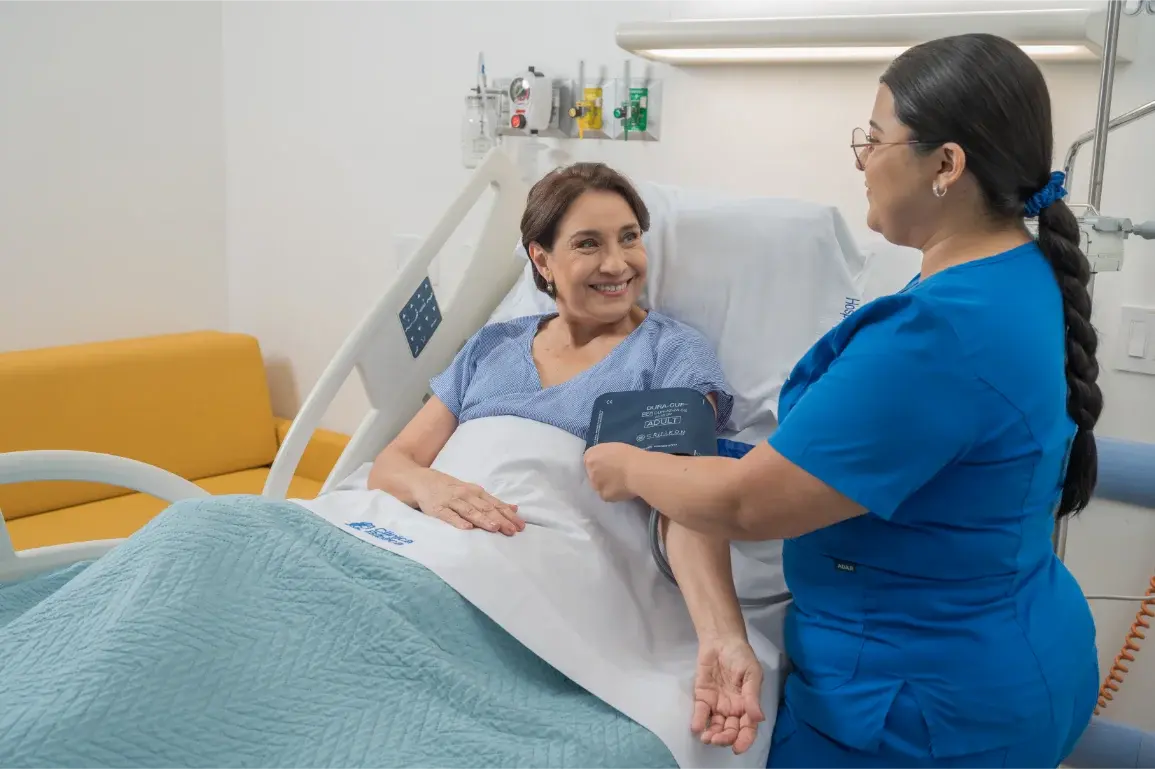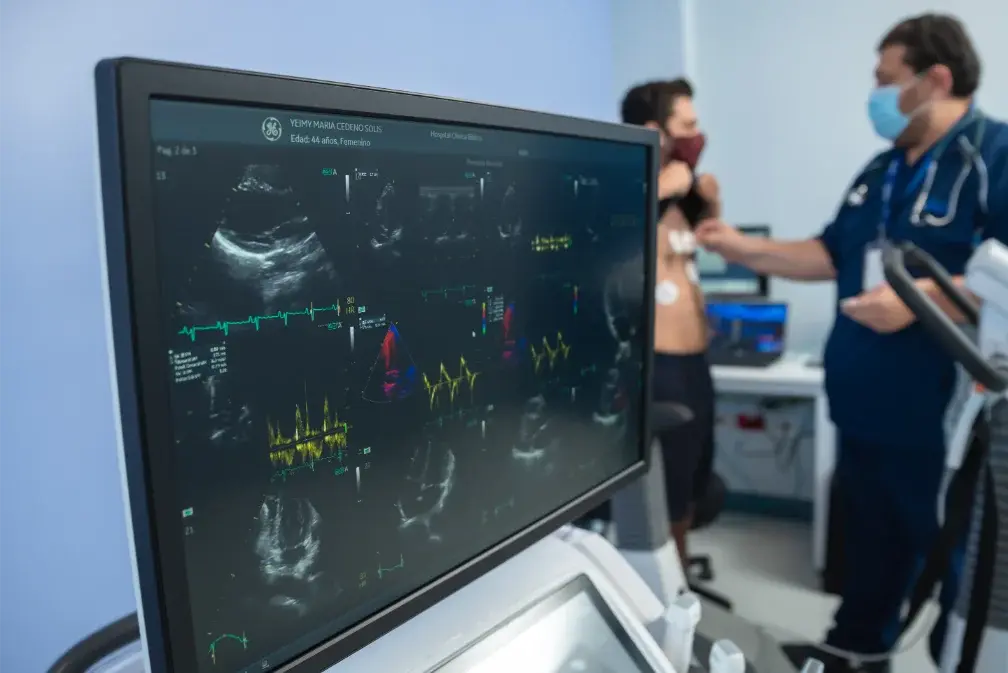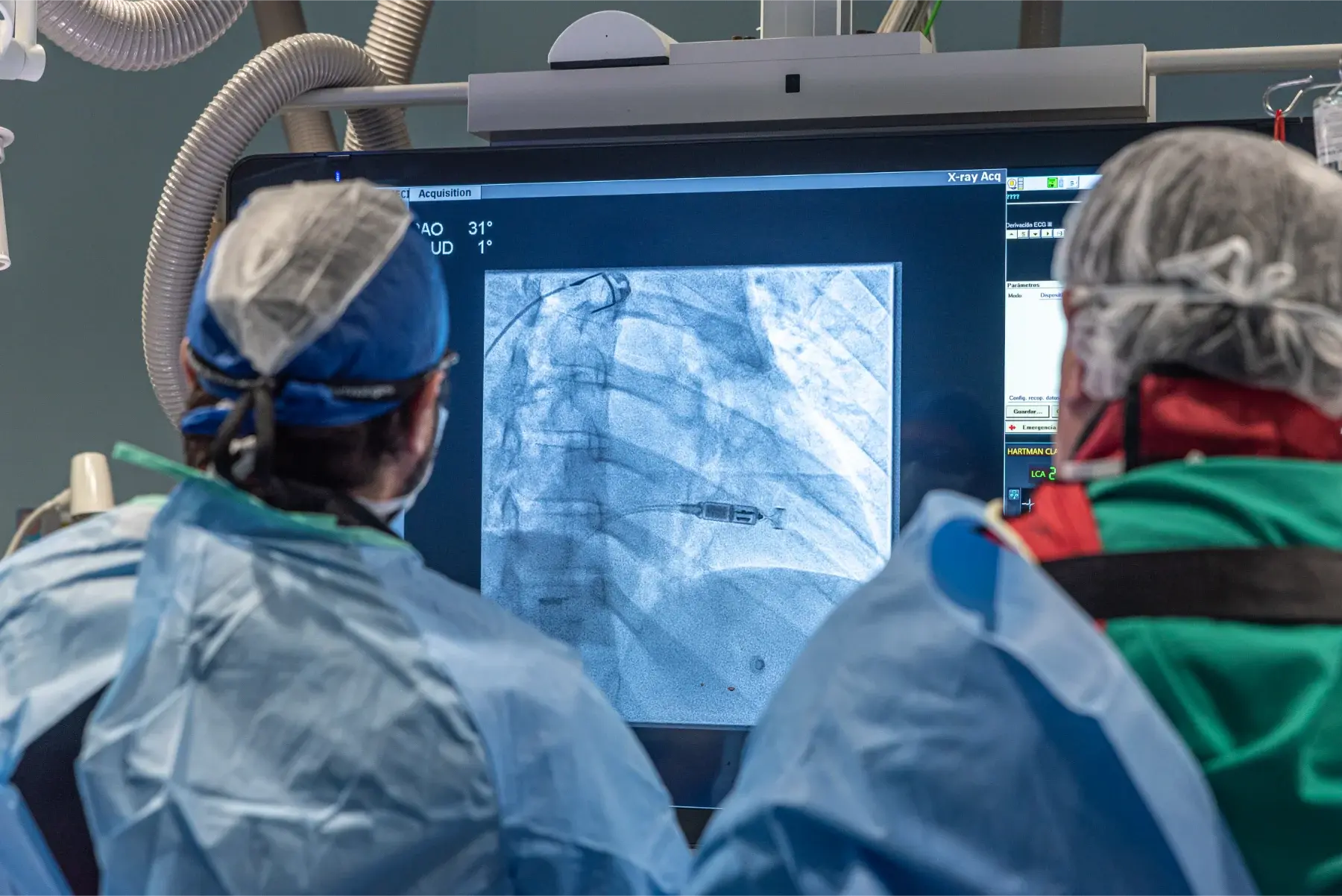Hemodynamics and Electrophysiology Laboratory
It is a specialized space where minimally invasive procedures are performed to diagnose and treat diseases of the heart and blood vessels. These procedures allow an accurate evaluation of the heart's function and treat conditions safely and with a faster recovery for the patient.

What is a hemodynamic procedure for?
Identify obstructions in the pipelines
Evaluate heart valve function and repair valve damage using devices (TAVI, MITRACLIP).
Measuring pressures inside the heart and blood vessels
Treating coronary obstructions to restore blood flow
Correct congenital heart defects.
Assessment of coronary arteries by coronary physiology and intravascular imaging.
Renal artery denervation for the treatment of arterial hypertension.
What is the function of Electrophysiology procedures?
- To accurately diagnose arrhythmias.
- Correct abnormal heart rhythms.
- Regulate the heartbeat with pacemakers or defibrillators.
- Monitor the heart to detect hidden arrhythmias.
- Prevent complications such as fainting and stroke.

Benefits of undergoing a hemodynamic and electrophysiology procedure.
- Minimally invasive procedures.
- Shorter hospitalization time.
- Faster recovery.
- Accurate diagnosis and treatment in the same procedure.
- Better control and prevention of cardiovascular complications.

How are Hemodynamics and Electrophysiology procedures performed?
During both types of procedures, a thin, flexible catheter is inserted through an artery or vein. With the help of real-time imaging with special x-ray guidance (fluoroscopy), the medical team guides the catheter to the heart.
In Hemodynamics
Coronary arteries, valves and chambers are evaluated to diagnose and treat problems such as blockages or narrowing. Interventions such as angioplasty or stenting can be performed in the same procedure.
In Electrophysiology
The electrical system of the heart is studied to identify and treat arrhythmias. Ablations may be performed to eliminate abnormal foci or devices such as pacemakers may be implanted to regulate the heart rhythm.
These procedures are minimally invasive, are performed under anesthesia and generally allow for a quick recovery, offering an accurate diagnosis and treatment in the same medical act.
Comprehensive care for your recovery
At Clínica Bíblica, in addition to having a team of top-notch interventional physicians, we provide you with an Intensive Care Unit (ICU), as well as a physiotherapy and cardiac rehabilitation team. This guarantees complete care, from the procedure to recovery, all in one place, so that you have the peace of mind of being in expert hands throughout your care process.

Our team of interventionalists
At Clínica Bíblica we have a team of highly specialized interventional physicians with extensive experience in advanced hemodynamic procedures. Our specialists remain at the forefront of the latest techniques and technologies, ensuring precise, safe and personalized care for each patient. Their commitment is to accompany you throughout the process, from diagnosis to recovery, with warmth and professionalism.

Hemodynamics and Electrophysiology Procedures
The Hemodynamics and Electrophysiology Laboratory performs minimally invasive diagnostic and treatment procedures, allowing cardiovascular health to be restored with less hospitalization time and rapid recovery.
Diagnostic cardiac catheterization
Study of coronary arteries and cardiac pressures through the introduction of a catheter.
Therapeutic cardiac catheterization
Interventional procedures to treat obstructions or other conditions detected during catheterization.
Coronariography
Visualization of the coronary arteries to identify obstructions or narrowing.
IVUS/OCT
Intravascular imaging to guide angioplasty procedures with or without stents and determine failure mechanisms of previous procedures
Endovascular mitral valve repair
Minimally invasive endovascular clip-on mitral valve repair in patients with severe valve insufficiency (MITRACLIP).
Transcatheter aortic valve replacement
Minimally invasive catheter-based aortic valve replacement (TAVI)
Coronary angioplasty with stent placement
Treatment of blocked coronary arteries, using balloons and stent placement to keep them open.
Peripheral hemodynamic studies
Assessment of blood flow in arteries and veins outside the heart
Valvuloplasties
Procedure to open narrowed heart valves by balloon catheter.
Congenital heart defect closure
Correction of heart structure defects present from birth, using minimally invasive techniques.
Electrophysiological study (EEF)
Invasive evaluation to map and diagnose arrhythmias by introducing catheters into the heart.
Radiofrequency ablation
Procedure to eliminate anomalous electrical sources that cause arrhythmias by applying controlled thermal energy.
Pacemaker implantation
Placement of a device that regulates heart rhythm in patients with bradycardia or blockages.
Implantable cardioverter defibrillator (ICD) implantation
A device that detects severe arrhythmias and delivers an electric shock to restore normal rhythm.
Implantation of implantable cardiac monitors
Devices that allow prolonged and continuous monitoring of the heart rhythm to diagnose arrhythmias.
Frequently Asked Questions
These procedures are performed with the assistance of an anesthesiologist, who administers the appropriate anesthesia for each case. The patient should not experience pain during the process.
It can last from 30 minutes to 4 hours, depending on the type of procedure.
Most patients can resume their daily activities within a few days, according to medical indications.

Cardio-Neuro-Vascular Service Network
We offer you a comprehensive network of cardiovascular, neurovascular and peripheral vascular services, with specialized care, advanced technology and a team committed to your well-being.
From prevention and early diagnosis, to treatment, surgery by specialty and rehabilitation, we accompany you so that you can live with peace of mind.
24/7 Emergencies
We attend to emergencies such as chest pain, heart attacks, arrhythmias, hypertensive crises and strokes immediately, with trained personnel and life support technology.
Hospitalization and Outpatient:
We comprehensively manage cardiac, cerebrovascular and peripheral vascular diseases such as hypertension, heart failure, coronary artery disease, peripheral arterial disease and cerebrovascular events, in a comfortable, safe and personalized environment.
Clinical Laboratory
- Specialized tests
- Cardiac markers (troponins, CK-MB)
- Lipid profile
- Coagulation tests
- Metabolic studies
Radiology
Advanced technology for the diagnosis of cardiac, vascular and neurovascular diseases:
- Echocardiogram
- Vascular Doppler
- Cardiac tomography
- Cardiac magnetic resonance imaging
- Non-invasive angiography
Neurology:
- Cerebral angiography
- Endovascular aneurysm closure
- Carotid angioplasty
- Treatment of vascular malformations.
Peripheral vascular:
- Vascular angiography
- Vascular angioplasty
- Vascular aneurysm treatment
- Phlebography
- Treatment of venous thrombosis
- Treatment of pulmonary thrombo embolism.
Surgery Room
Cardiovascular and vascular procedures are performed such as:
- Coronary artery bypass grafting (CABG)
- Heart valve repair or replacement
- Correction of congenital defects
- Aortic surgery
- Removal of cardiac tumors
- Arrhythmia ablation surgery
Cardiovascular Rehabilitation
- Supervised exercises
- Nutritional counseling
- Cardiovascular health education
- Warm and specialized care
- Advanced and safe technology
- Multidisciplinary team for your comprehensive care
- Prevention, diagnosis, treatment and rehabilitation in one place.
- Constant accompaniment throughout your process.
Frequently Asked Questions
Severe chest pain, shortness of breath, palpitations, fainting, weakness on one side of the body or sudden loss of vision.
No, you can schedule your appointment directly with our medical team.
Supervised exercise, health education and follow-up of healthy habits to improve recovery and your quality of life.
Yes, we have screening packages to detect risk factors early.


Contact us at
Patient Information
Insurance
We make using your medical insurance simple. Your time is valuable, so we manage your authorizations efficiently.